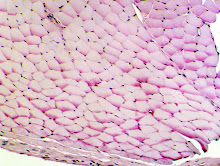Basically speaking, Cori-Forbes' Disease is a matebolic disease caused by a deficiency of the enzyme amylo-1,6-glucosidase which is vital in debranching. Muscle, heart and liver cells are typically involved and glycogen has a very hard time breaking down. Thus, there is an excess of glycogen in the liver and muscles. The two clinical variants are 1.an infantile form and 2.a juvenile form.
The biochemical subtypes include: type A, lack immunoreactivity and enzyme activity in both the liver and muscle cells, type B which is only concerned with the liver's immunoreactivity and enzyme activity and type C, a deficiency in transferase activity in both muscle and liver cells, but immunoreactivity and enzyme activities are normal.
What's Happening in Their DNA?
Forbes' disease affects chromosome 1p21 due to a multitude of variations and is autosomal recessive. Most patients are compound heterozygotes rather than true homozygotes.People with the disease also have hypoglycemia.
How do Patients with Forbes' Physically Look?
At birth, infected newborns look normal. Eventually as they develop, people with Forbes' Disease have puppet-like, or cherubic faces and have midfacial hypoplasia. Due to a lack in storage of glucose, people with Forbes' disease tend to crave carbohydrates and sweets. Most patients are also short compared to the average size of humans. Muscle weakness begins around a patient's twenties or thirties. They are usually tired simply because their muscles can't exert as much force as those of a normal person.
How is it Inherited?
Forbes', an inherited glycogen disorder, is autosomal recessive. If a person's parents are carriers, then that person is more likely to be a carrier or have the disease.
Are there any Carrier Forms and/ or Lethal Forms?
Side effects vary from person to person. Those with other diseases may experience mor complications than their counterparts. This form of GSD (glycogen storage disease type III) is much milder than GSD type I. However, there are four subtypes of GSD III: A, B, C, D. Types A and B are less severe than types C and D.
Is there any Treatment?
Doctors can monitor hepatomegaly and hypotonia and place patients on a diet high in protein and raw corn starch.
Patients can also go to physiotherapy to learn how to use their muscles properly.
Genetics - genetic counselling, prenatal diagnosis (cultured amniotic fluid cells display a decrease in amylo-1,6-glucosidase activity)
Eventually, some signs and symtoms will disappear after puberty.
Patients can also go to physiotherapy to learn how to use their muscles properly.
Genetics - genetic counselling, prenatal diagnosis (cultured amniotic fluid cells display a decrease in amylo-1,6-glucosidase activity)
Eventually, some signs and symtoms will disappear after puberty.
How Can Others Avoid Getting Forbes'?
Subscribe to:
Posts (Atom)





